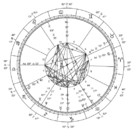Unsolved:Generational planet
| Astrology |
|---|
| Background |
| Traditions |
| Branches |
In the field of astrology, generational planets are planets that affect an entire generation of people. The generational planets are the outer planets Uranus, Neptune, and Pluto, and potentially Sedna and Quaoar.
Uranus
Uranus exhibits the ideals of the 18th century, when people such as Benjamin Franklin endeavoured to use their inventive mind to move man into a more enlightened era. It has an orbit of 84 years, staying in each sign of the zodiac for approximately 7 years.[1] Uranus is considered to be a higher octave of Mercury,[1][2] which means that as people develop within their selves, their character and means of communication will exhibit more influences of the sign and house of Uranus. In essence, Uranus can be seen as a person's higher self. Because it takes Uranus 84 years to travel through the zodiac, transiting Uranus might conjoin the natal Uranus within a person's lifetime.
Neptune
Neptune is a 19th-century planet in that it heralded in many of the varied Protestant denominations, as well as spiritualism. Visionaries such as Edgar Cayce and Rudolf Steiner were born in the second half of the 19th century, and their psychic abilities are indicative of the Neptunian themes of this time. It has an orbit of 165 years, spending approximately 15 years in each sign.[1]
Neptune is considered to be the higher octave of Venus[1][2] because both planets are gaseous and both strive to achieve the higher ideals of mankind; Venus through the adoption of beauty and Neptune through unconditional love.[3] Because Neptune has such a long orbit, an individual may see transiting Neptune form an opposition to their natal Neptune.
Pluto
Pluto is very much a 20th-century planet and refers to the two world wars, weapons of mass destruction, nuclear power, and a desire to totally control the world. It is a planet that reveals the extremes people are capable of if they do not set necessary boundaries in their lives.[1] This planet governs people's compulsions, the things they are compelled to do but know they should not, such as murder, rape, and drug addiction.
Pluto is considered to be a higher octave of Mars,[2] evidenced by the fact that both planets co-rule Scorpio. Pluto, circling the Sun in 248 years, has a rather elliptical orbit, which means that it stays in the sign it rules, Scorpio, for a mere 12 years, and the sign of its fall, Taurus for 30. With this in mind, some astrologers[who?] believe that Pluto should rule Taurus, but for the time being it still rules Scorpio. As other trans-Neptunian object planets are discovered, however, this placement may be reconsidered.
Potential generational planets
Quaoar was discovered on 4 June 2002[4] and is considered to be a trans-Neptunian object. Although a planetoid, it is considered by many[who?] to be more of a planet than Pluto because its orbit is more circular in nature, being 286 years. When a person is around 71 years old, transiting Quaoar will form a square aspect to his natal placement. Since this is a recently discovered object, not much is yet known about its astrological significance and what part it plays in the universe.
Sedna was discovered by a team using the Samuel Oschin telescope on 14 November 2003 and is a trans-Neptunian object.[5] It has an orbit of 11,250 years, so it stays in a sign for approximately a millennium. Because this planet has recently been discovered, not much is yet known about it.
See also
Citations
- ↑ Jump up to: 1.0 1.1 1.2 1.3 1.4 "This Is The Pluto Generation You Belong To, Based On Astrology" (in en-US). 2021-04-29. https://thoughtcatalog.com/nikki-halsted/2021/04/this-is-the-pluto-generation-you-belong-to-based-on-astrology/.
- ↑ Jump up to: 2.0 2.1 2.2 "Lower And Higher Octave Planets". 26 January 2015. http://astrologyclub.org/lower-higher-octave-planets/. Retrieved 2016-11-04.
- ↑ Broadbent, Christine (2009-11-25). "What does your Astrological Generation say about you? -" (in en-US). https://www.wellbeing.com.au/mind-spirit/What-does-your-Astrological-Generation-say-about-you.html.
- ↑ Williams, Matt (27 August 2015). "The Dwarf Planet Quaoar". http://www.universetoday.com/76906/quaoar/. Retrieved 2016-11-04.
- ↑ Williams, Matt (10 August 2015). "The Dwarf Planet Sedna". Universe Today. http://www.universetoday.com/37479/dwarf-planet-sedna/. Retrieved 2016-11-04.
 |


